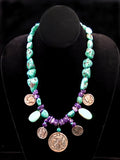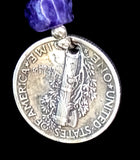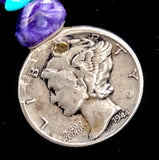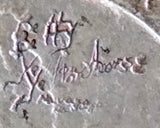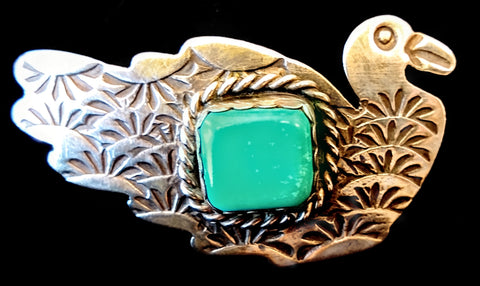
Navajo Turquoise, Charoite, and Sterling Silver Necklace by Betty Yellowhorse
$ 900.00
Native American Navajo necklace by Betty Yellowhorse - $900
NECKLACE:
18" L -- Necklace (open) without pendants
PENDANTS:
1-3/6" Diameter -- Walking Liberty Half Dollar Center Pendant
11/16" Diameter -- Liberty Mercury Dimes
1-1/8" L x 1/2" W -- Turquoise Cabochons
CLASP: Hook clasp
CONDITION: Vintage, Never Worn
This beautiful necklace, handmade by renowned Navajo artist Betty Yellowhorse, consists of a strand of turquoise nugget beads in a deep blue-green color, interspersed in the front with charoite nugget beads. The main pendant is a 1944 Walking Liberty half dollar and small turquoise cabochon. Other pendants include four Liberty Mercury dimes (dated 1939, 1942, and 1944), and two cabochons of a light shade of turquoise in a silver bezel setting. The back of this necklace is stamped sterling silver, and bears Yellowhorse's hallmark proving its authenticity.
Betty Yellowhorse is an accomplished silver smith, working in the rich Navajo tradition. She is known for incorporating beautiful old coins into her jewelry. Working with silver coins in jewelry is a practice which points to a time before the use of sheet silver and bezel wire, and so coin work taps the deepest roots of tradition in Navajo silver jewelry making. Betty Yellowhorse jewelry is imbued with the richness and beauty of this lineage, not only through traditional techniques and designs, but also by incorporating the long history held in such old coins.
The1944 Walking Liberty half dollar, with its obverse image of Lady Liberty walking toward the sunrise, is generally considered one of the most beautiful designs ever set on a US coin. The coin was designed by well-known sculptor and engraver, Adolph A. Weinman. Consisting of 90% silver and 10% copper, this coin was issued from 1916 to 1947 by the Untied States Mint.
The Liberty Mercury dime is an interesting coin, and one popular among coin collectors. Due to its resemblance to the Roman god, it came to be called a "Mercury" dime, but the winged head actually symbolizes liberty, specifically "liberty of thought." These ten-cent pieces were produced between 1916 and 1945 by the United States Mint, and are composed of 90 percent silver and 10 percent copper. Designed by well-known sculptor and engraver, Adolph A. Weinman, the design was quite popular in its day, but the coin presented problems when used in vending machines, so the design was modified in 1945.
Because these items are hand-crafted by local artisans using traditional techniques, slight variations may occur. Note that colors may vary according to each display monitor.

